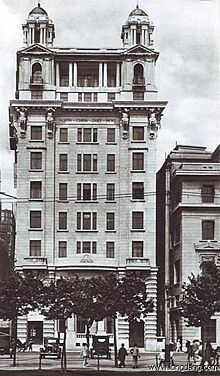 Front page of the inaugural issue of the North China Herald (August 3, 1850) Front page of the inaugural issue of the North China Herald (August 3, 1850) | |
| Type | Defunct |
|---|---|
| Founded | 1850 |
| Language | English |
| Ceased publication | 1941 |
| City | Shanghai |
| Country | China |
| North China Daily News | |||||||
|---|---|---|---|---|---|---|---|
| Traditional Chinese | 字林西報 | ||||||
| Simplified Chinese | 字林西报 | ||||||
| |||||||
The North China Daily News (in Chinese: Zilin Xibao), was an English-language newspaper in Shanghai, China, called the most influential foreign newspaper of its time.
History

The paper was founded as the weekly North-China Herald (T: 北華捷報, S: 北华捷报, P: Běihuá Jiébào) and was first published on 3 August 1850. Its founder, British auctioneer Henry Shearman (T: 奚安門, S:奚安门, P: Xī Ānmén), died in 1856.
A daily edition commenced publication on 1 June 1864 as the North China Daily News. The North-China Herald was also the gazette (official record) of the British Supreme Court for China and Japan and the British Consulate. Briton Nichol Latimer, resident of Shanghai and the manager of Russell & Company’s Shanghai Steam Navigation Co., was the publisher of the North China Herald from 1863 until his death in 1865, during which period it was the most influential British newspaper in China. For much of the period it was published under the masthead North-China Herald and Supreme Court and Consular Gazette. Its circulation peaked at 7,817 copies.
A notable early editor was Frederic H. Balfour. Other editors included Archibald John Little's brother R.W. "Bob" Little (C: 李德立, P: Lǐ Délì), who also served on the Shanghai International Settlement's Municipal Council.
In 1901, the paper was purchased by Henry E. Morriss (T:馬立斯, S:马立斯, P:Mǎ Lìsī). In 1920, the paper passed to his son, H.E. Morriss Jr., who used his money to build a compound of luxurious houses which became today's Ruijin Hotel, as well as the Canidrome, a dog-racing stadium. One of the two Morrisses also purchased the Hellier Stradivarius.
In 1924, the newspaper moved its headquarters to the new North China Daily News Building at Number 17 on the Bund, then the tallest building in Shanghai.
Between 1925 and 1949 the paper employed a former officer of the Russian Imperial Army, Georgi Sapojnikov, as its daily cartoonist. Drawing under the signature of "Sapajou" he was noted for his perceptive coverage of the complex politics of contemporary China and the extremes of life and society in Shanghai during this period.
The North-China Herald and the daily edition suspended publication after 8 December 1941 during the Pacific War. Publication of the Herald was never resumed. On 31 March 1951, the North China Daily News suspended publication at the orders of the ruling Chinese Communist Party and the North China Daily News Building was seized by the Shanghai municipal government of the People's Republic of China.
The Shanghai Library has an incomplete collection of back issues of the North China Daily News and the North-China Herald at the Bibliotheca Zi-Ka-Wei (in Xujiahui).
See also
- History of newspapers and magazines § China
- Shen Bao
- Shanghai Evening Post and Mercury
- Der Ostasiatische Lloyd
- Shanghai Jewish Chronicle
- Deutsche Shanghai Zeitung
References
- Xiaoqun Xu. Chinese Professionals and the Republican State: The Rise of Professional Associations in Shangahai, 1912–1937 Cambridge University Press, 2001. p. 45. ISBN 0-521-78071-3
- He, Sibing (2011). Russell and Company in Shanghai, 1843-1891:U. S. Trade and Diplomacy in Treaty Port China. Hong Kong University. p. 11.
- King; Clarke, eds., Frank H. H.;Prescott (1965). A Research Guide to China Coast Newspapers, 1822-1911. East Asian Research Centre, Harvard University. pp. 77, 122–133.
{{cite book}}:|last=has generic name (help)CS1 maint: multiple names: authors list (link) - City Guide to Shanghai
- Sergeant, Harriet (1998). Shanghai. pp. 34–35. ISBN 0-7195-5713-5.
External links
- Pan Haixia. "Witness to history." Shanghai Star. 20 November 2003. Retrieved 5 June 2008.
- "The English-language Newspaper scene, 1930s" An excerpt from Sin City, by Ralph Shaw, a British journalist who worked for the North China Daily News
| Shanghai | |||||||||||||||||||
|---|---|---|---|---|---|---|---|---|---|---|---|---|---|---|---|---|---|---|---|
| Administrative divisions |
| ||||||||||||||||||
| Culture and demographics |
| ||||||||||||||||||
| Tourist attractions |
| ||||||||||||||||||
| Places of worship |
| ||||||||||||||||||
| Skyscrapers |
| ||||||||||||||||||
| Sports venues |
| ||||||||||||||||||
| Sports teams |
| ||||||||||||||||||
| Transport |
| ||||||||||||||||||
| Universities |
| ||||||||||||||||||
| Foreign-language newspapers in China | |||||||||
|---|---|---|---|---|---|---|---|---|---|
| Mainland China |
| ||||||||
| Hong Kong |
| ||||||||
| Macau |
| ||||||||
| This list is incomplete. This list does not include English-language newspapers in Hong Kong, nor does it include Portuguese-language only newspapers in Macau. It does not include any newspapers in the current/post-Chinese Communist Revolution Republic of China area (Taiwan), nor in Taiwan under Japanese rule. | |||||||||